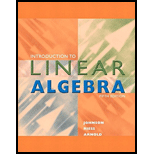
Concept explainers
Exercises 1-14 refer to the
|
|
|
|
|
|
|
|
|
|
|
|
In Exercises I-6, determine by inspection why the given set
Want to see the full answer?
Check out a sample textbook solution
Chapter 3 Solutions
Introduction to Linear Algebra (Classic Version) (5th Edition) (Pearson Modern Classics for Advanced Mathematics Series)
- Let S = be a set of k vectors in R^, with karrow_forwarda) [1√2-31x+1√3-11y = x (1 - √2) + √34 LI√2-21x-1√3-3/4= √34 - √2x-4arrow_forwardPlease Help me answer this linear algebra question. This is a practice textbook question.arrow_forward1. a scientist observed a bacterium in a microscope. it measured about .0000029 meter in diameter which of the following is closest to it? A- 2 x 10^-6, B- 2 x 10^-5, C- 3 x 10^-5, or D- 3 x 10^-6 2.express the product of 500 and 400 in scientific notation. is it 2 x 10^5 or 2 x 10^4 or 2 x 10^3 or 20 x 10^4arrow_forwardPlease Help me answer this linear algebra question. This is a practice textbook question.arrow_forwardPlease Help me answer this linear algebra question. This is a practice textbook question.arrow_forwardTY D om E h om ng 00 C B A G F Q ו 3 13 Details Find an Euler path for the graph. Enter your response as a sequence of vertices in the order they are visited, for example, ABCDEA. fic ► Question Help: Video Message instructor Submit Question tor arch 園 A Wind advisoryarrow_forwardYou are provided with three 2D data points, p1, p2 and p3. Solving A C = B for C provides youwith the coefficients of a natural cubic spline curve that interpolates these points.Additionally, you have been given A and B, but some elements are missing. Moreover, the last two rowsof A are entirely absent. Your task is to determine and fill in the missing elements. For the last two rows,enforce a zero tangent at the beginning (in p1) and a not-a-knot boundary condition in p2. The matricesA and B are given as follows:Explain how to find the entries of A and B . How would you adapt these matrices if the data pointswere 3D? What if your spline should go through five data points? How many “extra rows” would there thenbe (with “extra” meaning “in addition to securing C2-continuity”)?arrow_forwardWhich graph represents f(x) = √x-2+3?arrow_forwardPractice Assignment 5.6 Rational Functions M Practice Assig Practice Assignment 5.6 Rational Functions Score: 120/150 Answered: 12/15 Question 10 A Write an equation for the function graphed below 5 + 4 1 2 H + + -7 -6 -5 -4 -3 -2 -1 2 34567 | -2 ర y = Question Help: Video Message instructor Post to forum Submit Questionarrow_forwardit's not algebra 4th gradearrow_forwardCan you tell me if I answered and showed my work correctlyarrow_forwardarrow_back_iosSEE MORE QUESTIONSarrow_forward_ios
 Elementary Linear Algebra (MindTap Course List)AlgebraISBN:9781305658004Author:Ron LarsonPublisher:Cengage LearningAlgebra & Trigonometry with Analytic GeometryAlgebraISBN:9781133382119Author:SwokowskiPublisher:Cengage
Elementary Linear Algebra (MindTap Course List)AlgebraISBN:9781305658004Author:Ron LarsonPublisher:Cengage LearningAlgebra & Trigonometry with Analytic GeometryAlgebraISBN:9781133382119Author:SwokowskiPublisher:Cengage Linear Algebra: A Modern IntroductionAlgebraISBN:9781285463247Author:David PoolePublisher:Cengage Learning
Linear Algebra: A Modern IntroductionAlgebraISBN:9781285463247Author:David PoolePublisher:Cengage Learning Trigonometry (MindTap Course List)TrigonometryISBN:9781337278461Author:Ron LarsonPublisher:Cengage Learning
Trigonometry (MindTap Course List)TrigonometryISBN:9781337278461Author:Ron LarsonPublisher:Cengage Learning



